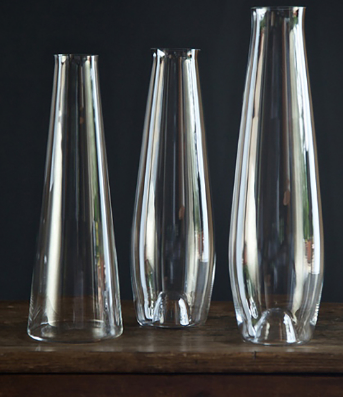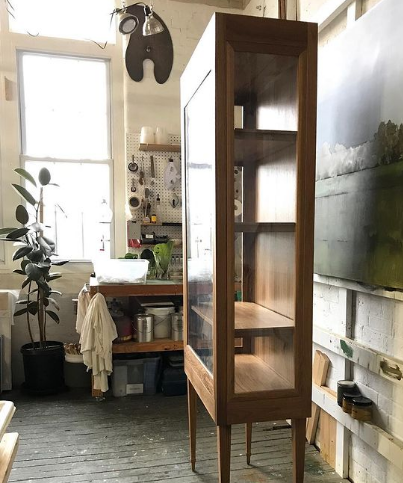Deborah Ehrlich:
The Timelessness of Modest Beauty

© Sarah Weal for The Garnered: Deborah Ehrlich with her glassware
"A designer knows he has achieved perfection not when there is nothing left to add, but when there is nothing left to take away."
- Antoine de Saint-Exupery
It was actually thanks to the images of the American photographer Don Freeman that I discovered the creative world of Deborah Ehrlich, glassware and furniture designer, living and working in the early 18th-century farmhouse in the Hudson Valley, New York. The delicate paper-thin glassware hand blown in Sweden, exposed on hand crafted furniture pieces, immediately caught my attention, demonstrating Ehrlich's purposeful preoccupation with space, light, and proportions.

© Deborah Ehrlich: glassware and handmade chairs, www.deborahehrlich.com

© Deborah Ehrlich: decanters for Blue Hill at Stone Barns, www.deborahehrlich.com
Born in New Jersey, Deborah Ehrlich has been designing high-end glassware since 1999. Her pieces have been featured in Takashimaya NY, Moss, March SF, MoncXIII, Blue Hill at Stone Barns, ER Butler, The Garnered and Inness. Contemplating Ehrlich's design pieces, I can confirm Jon Franklin's statement that simplicity, carried to an extreme, becomes elegance. Even a superficial eye can remark the meticulous research and attention to detail behind her design pieces. A symbiotic, intimate relationship between the object and the surrounding environment results in harmony and stillness.
Ana:
Could you tell us a bit about how did you manage to build your brand? What was the key to your success?
Deborah Ehrlich:
I didn’t concern myself with a brand, I just stuck to my values, and was lucky enough to find other people with the same values. But more importantly, It’s better for me to focus on the integrity of the work rather than how it’s perceived.
And the choices I’ve made - have been to protect the one real wish I have: for a person to be filled with an irrational desire for the work without knowing why. If I were to promote a brand, my primary goal would be destroyed.

© Deborah Ehrlich: decanter with slanted lip, photographed by Lauren Coleman. Source: www.deborahehrlich.com
Besides her studies at Barnard and design at the Danish Design School in Copenhagen, Ehrlich also studied sculpture under the direction of Michael Skop in Kentucky.
Ana:
While reading your biography, I spotted one curiosity that captivated my attention: In Kentucky, you studied under the direction of Michael Skop, a student of the famous Croatian sculptor Ivan Mestrovic. In what sense did studying sculpture influence your design path?
Deborah Ehrlich:
When I got to Mike’s studio and was new there, he was giving a lecture on Miro, and he was drawing examples of how the movement in time, in the compositions, was intuitive and not literal. I remember it was the first lecture showing me how the thought or feeling behind the hand was valid and was a way of communicating, but I didn’t see what he was talking about yet. I was clearly confused, but he kept asking, “Deborah do you see that?” and then he’d look up at me and say, “just say yes, just say yes."
He’d continue with the demonstration, I still was thinking literally and not intuitively, and he’d continue to ask, “Do you see that?” and look up at my confusion and say, “Just say yes.”
So- just saying yes put my mind in a receptive space- it took me out of an analytical rational space and brought me into an openness. And the way I design, the way I approach communicating with design, is a leap of faith. It’s intuitive. And maybe to be intuitive you have to be in the mindset of a potential Yes.
Apart from Mike, Ehrlich also mentions the influence of her friend, painter and sculptor Diane Szczepaniak, who explored the dynamics of form in space throughout her artistic career, referring to her paintings and sculptures as places.

The Light and Dark Side of the Moon, Diane Szczepaniak, from Chance Encounter at Park Towne Place. Source: https://inliquid.org/from-inliquid/in-memory-of-diane-szczepaniak-2/
Deborah Ehrlich:
Also, from my time studying with Mike, I walked away with my friendship with Diane Szczepaniak, another student there- a painter and sculptor who understood timelessness and space, worked relentlessly and was someone I always turned to for her insight. She’d talk about form and authenticity, but if I asked her for feedback on a design, she’d say, “Deborah, if you have to ask, it’s not done yet.”.
I design like I’m stepping on stepping stones in a stream, one sure foot in front of the other- one clear note in front of the other. She was right; when a piece comes to a conclusion, the designer has no doubt that it’s a pure experience. Luckily she was captured in lectures so that her insights can help others, her understanding of pure form is compassionate and uplifting, and I never work without thinking of her guidance.

© Deborah Ehrlich: the "Hurricane Lanterns", www.deborahehrlich.com
During the eight years of traveling through Europe, from 1990 until 1998, Ehrlich collected precious knowledge while helping to restore the stained-glass of St. Stephan’s Cathedral in Vienna and sculpting large-scale installations from local materials in Provence. Her first glass object- a champagne flute, was actually inspired by French glass wine tumblers. In Copenhagen, she discovered the blown-glass technique. Noticing Scandinavian references in Ehrlich's furniture design, I was curious to know the special connection with Sweden, as all of her glassware is hand blown, cut, and polished by Swedish craftsmen.
Ana:
Is there a particular reason why your glass is produced in Sweden? I am asking you this question because I notice Scandinavian references in your furniture design.
Deborah:
In all honesty, at first, I was hoping for an excuse to see my friends in Copenhagen on work-related trips- I had lived in Copenhagen, and don’t forget, I was about 30 when I started my company, so I was trying to make it fun.
But also, the Scandinavians have a long history of mutual respect between artisans and designers. If I wasn’t going to be making the work with my own hands, I wanted a completely perfect match with my artisan. I chose to work with one glassblower- one small team of cold glassworkers.
It’s been incredible. Their personalities are in the work as much as mine is, and I love their personalities- on an aesthetic level, it’s a perfect match. On a business level, it’s also a perfect match- it’s easy, honest, respectful, and mutually supportive. Basically, we’re on the same team, and I’m grateful and proud of them every time I see new work.

© Deborah Ehrlich: writing desk table and chair. Source: @deborahehrlich

© Deborah Ehrlich, chairs. Source: @deborahehrlich
The timelessness of Ehrlich's design is possibly best shown in the wooden furniture pieces, where hickory and ash wood is used in a way similar to crystal, strong enough to be thin. These modest pieces produced by an artisan in New England that perfectly stand on their own show her intuitive understanding of the dynamics of form. With a leap of faith, as she points out, a final form can result from everything. This genuine, authentic design approach manifests in making visible "that" which the thing expresses, the natural energy of the object. The ethereal aspect of the wooden chairs can easily suggest inspiration from a musical piece.

© Deborah Ehrlich: The Dahl-Frantzis Vitrine, @deborahehrlich
Ana:
Andrée Putman once said that we only invent so little, most of the designer’s inspiration comes from the past that is so rich in references. You live in a historic stone farmhouse from the 1770s in the Hudson Walley full of vintage mid-century furniture. Could we say that there is a kind of fascination with the past? And more so, with the French Province type stone houses?
Deborah:
I appreciate my nest thermostats as much as the hand-hewn beams. I love the simplicity of the latch on the smokehouse- it's genius design using gravity. I use that when I think of my own work-gravity is a tool; farmers knew that when they made their tools. But I don’t prefer historical things on principle.
As a visual person, though- I am sensitive to the personality of the workmanship in physical objects, which is why when I worked on the restoration of the stained-glass windows in St. Stephan’s Cathedral in Vienna- I felt uplifted by the devotion they used when originally making that work. That devotion translates through the objects - it’s anonymous, heartfelt. People who built this house built it for the people they loved, and I enjoy that.
The beauty of Deborah Ehrlich's design, in my opinion, lies in the depth of thought behind her creative process, which manifests in the way we perceive her objects. I could never find more appropriate words to describe this term, as Diane Szczepaniak did in The Artist's Space, a video project from 2019 and a kind of artistic statement referring to the teaching of Michael Skop: "How you think can be put in that form through touch. In the end basically that's all you want, is for that thought depth to be the only thing anybody sees because basically they are not really seeing your art with their eyes, they're seeing it with their mind." (Szczepaniak, The Artist's Space, 2019, 02:27-02:52)
In that thought process that Ehrlich succeeded to make visible, lies maybe the secret of her design's timeless, quiet beauty: the uniqueness of everyday objects that exceed their primary use by their meaningfulness.

© Deborah Ehrlich: small crystal bowl for Blue Hill at Stone Barns, @deborahehrlich
"I sort of identify with an idea that the curve is actully doing something, so there is a meaning in the curve."
-Diane Szczepanik from the Mini-doc: Diance Szczepaniak's CURSIVE
Contact:
Deborah Ehrlich's official website: www.deborahehrlich.com
Instagram: @deborahehrlich
E-mail: info@deborahehrlich.com
Sources and references:
Diane Szczepaniak official website, http://www.dianeszczepaniak.com
Don Freeman, Deborah Ehrlich- don freeman photo, https://www.donfreemanphoto.com/deborah-erhlich
E.R. Butler & Co., Deborah Ehrlich, https://www.erbutler.com/designers/ehrlich
Roaring Pictures: Diane Szczepaniak's CURSIVE, mini-doc,2019, https://vimeo.com/320790978
Roaring Pictures: The Artists's space, Diane Szczepaniak, 2019, https://vimeo.com/326420562
Timber time: refined designer Deborah Ehrlich swaps crystal for wood, by Aaron Peasley, Wallpaper, https://www.wallpaper.com/design/deborah-ehrlich-debuts-delicate-wooden-chair-at-er-butler-co, 6 July 2016
Add comment
Comments
I had a chance to see the glassware by Deborah Ehrlich on The Garnered site. Absolutely love her aesthetic. Interested to get to know her artistic background. Lovely article!
C est avec grand plaisir que je découvre la finesse du juste parfais Amen